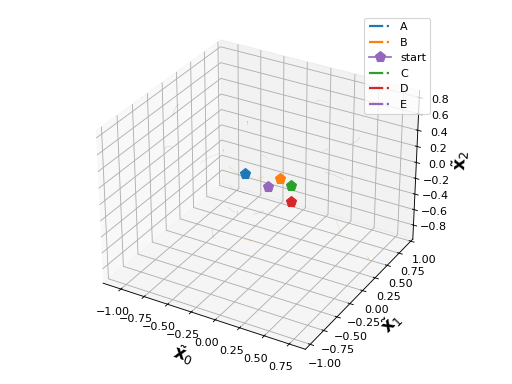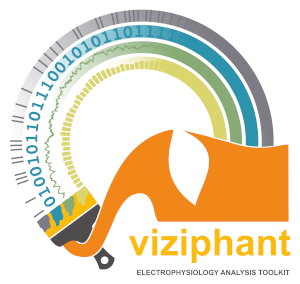viziphant.gpfa.plot_trajectories¶
- viziphant.gpfa.plot_trajectories(returned_data, gpfa_instance, dimensions=[0, 1], block_with_cut_trials=None, neo_event_dict={}, orthonormalized_dimensions=True, trials_to_plot=array([0, 1, 2, 3, 4, 5, 6, 7, 8, 9, 10, 11, 12, 13, 14, 15, 16, 17, 18, 19]), trial_grouping_dict=None, colors='grey', markers=('.', 'o', 'v', '^', '<', '>', '8', 's', 'p', '*', 'h', 'H', 'D', 'd', 'P', 'X'), plot_group_averages=False, plot_args_single={'alpha': 0.4, 'linestyle': '-', 'linewidth': 0.3}, plot_args_marker={'alpha': 0.4, 'markersize': 5}, plot_args_average={'alpha': 1, 'linestyle': 'dashdot', 'linewidth': 2}, plot_args_marker_start={'label': 'start', 'marker': 'p', 'markersize': 10}, figure_kwargs={}, verbose=False)[source]¶
This function allows for 2D and 3D visualization of the latent space variables identified by the GPFA.
Optional visual aids are offered such as grouping the trials and color coding their traces. Changes to optics of the plot can be applied by providing respective dictionaries.
This function is an adaption of the MATLAB implementation by Byron Yu which was published with his paper: (Yu et al., 2009)
- Parameters:
- returned_datanp.ndarray or dict
When the length of returned_data is one, a single np.ndarray, containing the requested data (the first entry in returned_data keys list), is returned. Otherwise, a dict of multiple np.ndarrays with the keys identical to the data names in returned_data is returned.
N-th entry of each np.ndarray is a np.ndarray of the following shape, specific to each data type, containing the corresponding data for the n-th trial:
latent_variable_orth: (#latent_vars, #bins) np.ndarray
latent_variable: (#latent_vars, #bins) np.ndarray
y: (#units, #bins) np.ndarray
Vsm: (#latent_vars, #latent_vars, #bins) np.ndarray
VsmGP: (#bins, #bins, #latent_vars) np.ndarray
Note that the num. of bins (#bins) can vary across trials, reflecting the trial durations in the given spiketrains data.
- gpfa_instanceGPFA
Instance of the GPFA() class in elephant, which was used to obtain returned_data.
- dimensionslist of int, optional
List specifying the indices of the dimensions to use for the 2D or 3D plot. Default: [0, 1]
- block_with_cut_trialsneo.Block or None, optional
The neo.Block should contain each single trial as a separate neo.Segment including the neo.Event with a specified neo_event_name. Default: None
- neo_event_dictdict, optional
Dictionary of names and properties of the events that should be plotted onto each trajectory. The key specifies the label appearing in the legend. The item specifies the neo_event_properties, which are used by neo.utils.get_events() to filter the event. In case more than one event per dict-entry is available, only the first one is chosen to be plotted. Please specify more properties to narrow down the choice in that case. Default: {}
- orthonormalized_dimensionsbool, optional
Boolean which specifies whether to plot the orthonormalized latent state space dimension corresponding to the entry ‘latent_variable_orth’ in returned data (True) or the unconstrained dimension corresponding to the entry ‘latent_variable’ (False). Beware that the unconstrained state space dimensions ‘latent_variable’ are not ordered by their explained variance. These dimensions each represent one Gaussian process timescale $ au$. On the contrary, the orthonormalized dimensions ‘latent_variable_orth’ are ordered by decreasing explained variance, allowing a similar intuitive interpretation to the dimensions obtained in a PCA. Due to the orthonormalization, these dimensions reflect mixtures of timescales. Default: True
- trials_to_plotstr, int, list or np.array(), optional
Variable that specifies the trials for which the single trajectories should be plotted. Can be a string specifying ‘all’, an integer specifying the first X trials or a list specifying the trial ids. Internally this is translated into a np.array() over which the function loops. Default: np.arange(20)
- trial_grouping_dictdict or None, optional
Dictionary which specifies the groups of trials which belong together (e.g. due to same trial type). Each item specifies one group: its key defines the group name (which appears in the legend) and the corresponding value is a list or np.ndarray of trial IDs. Default: None
- colorsstr or list of str, optional
List of strings specifying the colors of the different trial groups. The length of this list should correspond to the number of items in trial_grouping_dict. In case a string is given, all trials will share the same color unless trial_grouping_dict is specified, in which case colors will be set automatically to correspond to individual groups. Default: ‘grey’
- markerslist of str, optional
List of strings specifying the markers of the different events. Default: Line2D.filled_markers
- plot_group_averagesbool, optional
If True, trajectories of those trials belonging together specified in the trial_grouping_dict are averaged and plotted. Default: False
- plot_args_singledict, optional
Arguments dictionary passed to ax.plot() of the single trajectories.
- plot_args_markerdict, optional
Arguments dictionary passed to ax.plot() for the single trial events.
- plot_args_averagedict, optional
Arguments dictionary passed to ax.plot() of the average trajectories. if ax is None.
- plot_args_marker_startdict, optional
Arguments dictionary passed to ax.plot() for the marker of the average trajectory start.
- figure_kwargsdict, optional
Arguments dictionary passed to
plt.figure(). Default: {}- verbose: bool
Print hopefully helpful messages for debugging purposes. Default: False
- Returns:
- figmatplotlib.figure.Figure
- axesmatplotlib.axes.Axes
Examples
In the following example, we calculate the neural trajectories of 20 independent Poisson spike trains recorded in 50 trials with randomized rates up to 100 Hz and plot the resulting orthonormalized latent state space dimensions.
import numpy as np import quantities as pq from elephant.gpfa import GPFA from elephant.spike_train_generation import StationaryPoissonProcess from viziphant.gpfa import plot_trajectories from matplotlib import pyplot as plt data = [] for trial in range(50): n_channels = 20 firing_rates = np.random.randint(low=1, high=100, size=n_channels) * pq.Hz spike_times = [StationaryPoissonProcess(rate=rate ).generate_spiketrain() for rate in firing_rates] data.append(spike_times) gpfa = GPFA(bin_size=20*pq.ms, x_dim=8) gpfa.fit(data) results = gpfa.transform(data, returned_data=['latent_variable_orth', 'latent_variable']) trial_id_lists = np.arange(50).reshape(5, 10) trial_group_names = ['A', 'B', 'C', 'D', 'E'] trial_grouping_dict = {} for trial_group_name, trial_id_list in zip(trial_group_names, trial_id_lists): trial_grouping_dict[trial_group_name] = trial_id_list plot_trajectories(results, gpfa, dimensions=[0, 1, 2], trial_grouping_dict=trial_grouping_dict, plot_group_averages=True) plt.show()
(
Source code,png,hires.png,pdf)
